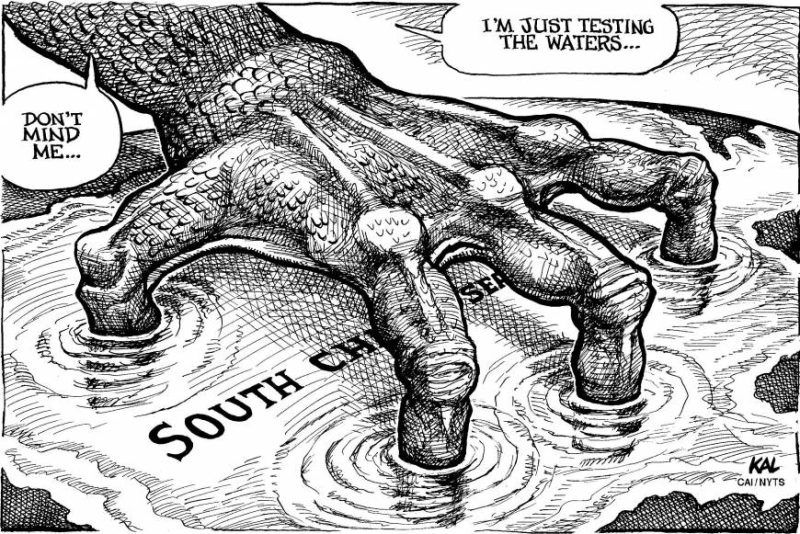
Recently it was reported in sections of the media that the United States and India have held talks about conducting joint naval patrols that could possibly include the disputed South China Sea.
The U.S. and Indian government officials were quick to dismiss the report. Washington suggested that while the U.S. and India have a shared vision of peace, stability and prosperity in Asia, the two countries were not planning joint maritime patrols in the Indian Ocean or South China Sea. New Delhi also argued that there was no change in India’s policy of joining international military efforts only under the U.N. flag.
China, not surprisingly, reacted swiftly and angrily, warming the U.S. and India that “countries from outside the area must stop pushing forward the militarization of the South China Sea, cease endangering the sovereignty and national security of littoral countries in the name of ‘freedom of navigation’ and harming the peace and stability of the region.”
Even though it seems clear that the U.S. and India are not yet politically ready for joint patrols, the trial balloon itself is indicative of the rapidly evolving Indian position on one of the key disputes in the Asian strategic landscape. A number of factors are forcing India’s hand.
The U.S. itself has been forced to adopt a more robust posture in the Indo-Pacific region. The dramatic acceleration in American military commitment to the region is largely a function of the astonishing rise of China.
China is today on the cusp of becoming a serious regional military power and this transition appears all the more menacing because of China’s aggressive posturing in the East and South China Seas.
Since most of China’s territorial conflicts are spread across the East and South China Seas, naval force projection has gained uncharacteristic momentum for a country that has had for most of its history a continental mindset. China’s maritime strategy and its increasing capabilities may simply overwhelm the smaller powers in the region. With respect to extra-regional powers such as the U.S., China’s singular objective is to deny them any operational space in its oceanic sphere of influence.
Against this background, Obama’s “pivot” toward Asia represents a simultaneous attempt to warn China away from using heavy-handed tactics against its neighbors and provide confidence to other Asia-Pacific countries that want to resist pressure from Beijing now and in the future. In response, China has accused Washington of seeking maritime hegemony in the name of freedom of navigation.
American officials have found a strategic partnership with India attractive, especially in guarding the Indian Ocean from the negative fallouts of China’s rapid rise. Washington continues to express its appreciation of India as a net security provider in the Indian Ocean region.
Maritime security cooperation between India and the U.S. has become a strategic necessity, especially for sustaining a favorable strategic equilibrium as Chinese power rises. India is having to respond to this burden of growing expectations and it has its own reasons for challenging China. China’s anti-piracy operations in the Gulf of Aden have raised hackles with some in the Indian Navy questioning the need for the continuous deployment of two frontline Chinese warships and a tanker. But the rivalry also extends to waters beyond Malacca.
If for China the Indian Ocean is not an Indian lake, New Delhi’s imperative is to contest impressions in Beijing that the waters east of Malacca automatically fall under the latter’s sphere of influence. India’s naval engagement in the East, therefore, has also been a reaction to China’s expansion in the Indian Ocean region. The turf war between the two navies, as both nations further prosper and seek greater roles in regional dynamics, is set to grow.
Least ideologically driven and also the most strategic minded of all the services in India’s defense establishment, the navy has long articulated the need to expand the nation’s maritime vision. In their recent joint statements, both the U.S. and India have repeatedly declared their support for freedom of navigation in the South China Sea, signaling that the Modi government is not reluctant to highlight New Delhi’s convergence with Washington on regional issues.
India’s engagements with states like Japan, Vietnam and Philippines have become more serious. India has publicly supported Vietnam and the Philippines in their disputes with China. Indian naval ships have been visiting Vietnam and the two nations have continued to cooperate on hydrocarbon exploration in the South China Sea despite Beijing’s warnings.
India and Japan have taken a public stand on South China Sea issue in recent years. During Prime Minister Shinzo Abe’s visit to India in December, the two nations called on all states to avoid unilateral actions that could lead to tensions in the region in view of the critical importance of the sea lanes in the South China Sea. They underscored the need for full and effective implementation of the 2002 Declaration on the Conduct of Parties in the South China Sea and early conclusion of the negotiations to establish a Code of Conduct in the South China Sea by consensus.
China promptly expressed its disapproval by labeling India and Japan as “countries outside the region.”
Joint patrols with America or not, India is conceiving a new and more ambitious role for itself in East Asia and Indo-U.S. interests in the region are converging at an unprecedented rate. It is now up to New Delhi and Washington to take full advantage of these developments.
Harsh V. Pant teaches in the Defense Studies Department at King’s College London with a focus on Asian security.
